Introduction
When it comes to skiing and snowboarding, most people focus on choosing the right boots, jackets, and helmets. Yet, one of the most overlooked pieces of gear is also one of the most important: your socks. Many beginners often wonder what kind of socks to wear for skiing or snowboarding, or whether ski and snowboard socks are the same. The right choice can make the difference between a warm, comfortable day on the slopes and a miserable experience filled with cold feet, blisters, and poor performance.
In this guide, we’ll cover the difference between ski and snowboard socks, what materials and thickness to choose, and how to wear them correctly. You’ll also discover why Max Hosiery’s custom high-performance ski socks are trusted by ski schools, resorts, and passionate riders.
Why Skiing and Snowboarding Require Specialized Socks
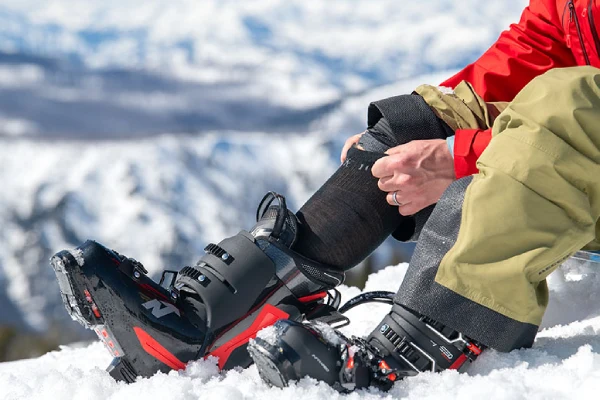
At first glance, socks may seem like a small detail, but when skiing or snowboarding, they’re crucial for comfort and performance. Many wonder what kind of socks to wear for skiing or snowboarding—and whether ski and snowboard socks are the same. In reality, specialized ski and snowboard socks are designed differently to match each sport’s demands.
Comfort and Performance: Ski boots and snowboard boots fit snugly. Without proper socks, you risk blisters and pain. Ski socks often have extra shin padding, while snowboarding socks focus more on ankle support.
Warmth and Circulation: Thick or cotton socks trap moisture and restrict blood flow, making your feet colder. High-performance ski and snowboard socks use moisture-wicking fibers that keep feet warm and dry all day.
Bottom line: The right socks for skiing or snowboarding aren’t accessories—they’re essential gear that keeps you warm, comfortable, and performing your best.
Materials: Merino Wool vs. Synthetic Fibers vs. Blends

Merino Wool
If you’ve ever wondered what ski socks are made of, merino wool is often the premium answer. It’s the top material choice for both ski and snowboard socks thanks to its excellent insulation, breathability, and odor resistance. Unlike traditional wool, merino fibers are soft and smooth against the skin, offering consistent warmth even when damp—making them perfect for long days carving through snow.
Synthetic Fibers
Synthetic materials like polyester, nylon, and acrylic are durable, quick-drying, and affordable. They’re also common in compression socks for snowboarding because of their stretch and moisture control. For large-scale customization, these fibers make a smart option for ski schools, rental shops, and retailers that need bulk branded socks without compromising performance or comfort.
Blended Fabrics
Many high-performance snowboarding socks use a blend of merino wool and synthetic fibers. This combination enhances warmth, durability, and flexibility, creating a sock that stays supportive and maintains its shape throughout the day. Blends often include a bit of elastane or spandex—features sometimes found in compression ski socks—to ensure a snug and secure fit inside the boot.
Avoid Cotton
Cotton remains the worst choice for skiing or snowboarding. It absorbs sweat, dries slowly, and traps moisture, making your feet heavy and cold inside boots. It also increases the risk of blisters. For any winter sport, cotton should be avoided entirely in favor of technical materials like merino wool or engineered synthetics.
Thickness and Cushioning: Thin vs. Thick
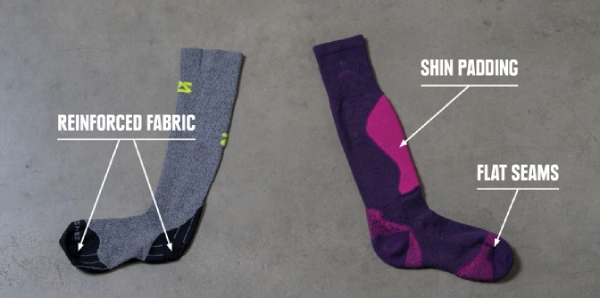
One of the most common misconceptions about ski and snowboard socks is that thicker always means warmer. But how thick should ski socks be to keep your feet warm without compromising comfort? In reality, the opposite is often true—warmth depends more on circulation than bulk.
- Ultralight / Thin Socks:
Designed for performance skiers and snowboarders, these are the best socks for skiing and snowboarding when precision and control matter most. Because modern boots have insulated liners, thin socks are usually sufficient for warmth while allowing better feel and responsiveness. - Light to Medium Cushioning:
This is the most popular choice for everyday riders. Light cushioning offers targeted padding at the shin and heel for comfort without bulk, while medium cushioning adds extra warmth for colder days or slightly looser-fitting boots. If you’ve ever wondered do ski socks need to be tight, the answer is no—compression should be gentle enough to support circulation, not restrict it. - Heavy Cushioning:
Best reserved for extreme cold conditions or for professionals like ski patrol and instructors who spend long hours outdoors. Heavy socks, however, can compromise boot fit and should be used carefully. When choosing thicker options, it also helps to consider how long ski socks should be—they should always rise above the boot cuff to prevent rubbing and maintain warmth. - The Circulation Factor:
Overly thick socks can actually restrict blood flow, making feet colder rather than warmer. A thinner, well-fitted sock that allows proper circulation will keep toes warmer than a bulky one that compresses them.
For businesses: Ski schools, clubs, and retailers can select the right cushioning levels for their audiences—lightweight performance socks for advanced athletes, or medium-thickness socks for beginners and rentals who need a balance of warmth and durability. Highlighting the difference between ski and snowboard socks can also help customers find the perfect fit for each activity.
Design and Technical Features
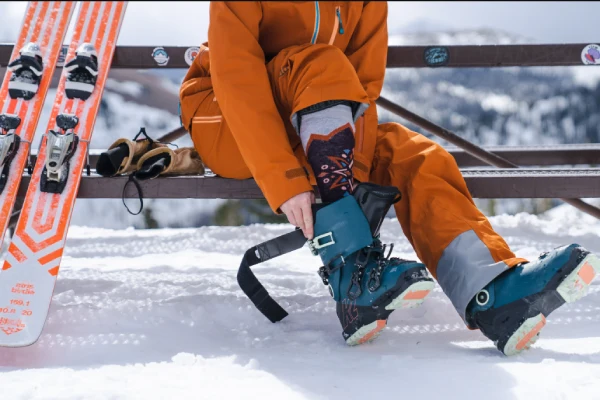
Modern ski and snowboard socks are far from being “just socks.” They are high-performance snowboarding and skiing accessories carefully engineered to work in harmony with your boots—enhancing comfort, warmth, and precision on every run. Whether you’re looking for compression socks for snowboarding or lightweight performance ski socks, the best designs share several advanced features that set them apart.
- Seamless Construction: High-quality socks eliminate bulky seams, especially at the toes, to prevent rubbing and blisters inside snug boots.
- Targeted Padding: Extra reinforcement is often placed at pressure points such as the shin, heel, and toes. This reduces discomfort from boot pressure and helps protect against shin bang.
- Elastic Arch and Ankle Support: Built-in compression zones around the arch and ankle provide a supportive, “locked-in” feel that minimizes fatigue and keeps the sock in place throughout the day.
- Graduated Compression: Some advanced socks apply gentle pressure from the ankle upward to encourage blood circulation, which not only reduces soreness but also helps keep toes warmer.
- Over-the-Calf Length: Ski and snowboard socks are designed to rise above the boot cuff. This protects the shin and ensures that the boot liner never rubs directly against skin.
- Stay-Up Cuff: A strong but comfortable elastic cuff at the top ensures that socks don’t slip down during active movement.
- Customization Potential: Beyond technical performance, design elements such as colors, patterns, and logo integration allow businesses, clubs, and resorts to transform socks into a branding tool.
How to Wear Ski Socks Correctly
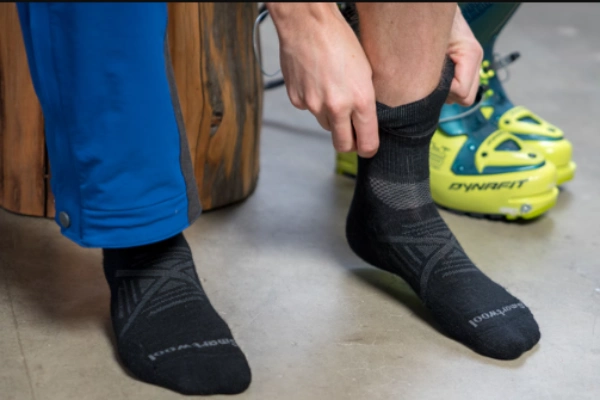
Even the best-designed ski socks won’t perform as intended if they’re worn incorrectly. Many beginners wonder whether to wear anything under ski socks or how tight they should feel. Small mistakes in layering or fit can quickly lead to discomfort, blisters, or cold feet. Here are the best practices for layering socks for skiing the right way:
- Wear Only One Pair:
Doubling up on socks may seem like a good way to stay warm, but it usually has the opposite effect. Wearing two pairs of ski socks creates friction, increases the chance of blisters, and restricts circulation—leaving your feet colder. The best approach is to wear one good pair of ski socks directly against your skin. - Against the Skin:
Ski socks should always be worn directly against your skin. Do not pull thermal base layers or leggings inside the sock. Extra fabric inside your boot creates wrinkles and pressure points. If you wear long base layers, make sure they sit over your ski socks, not inside. This ensures smoother contact and better comfort throughout the day. - Smooth, No Wrinkles:
Take a moment to pull the sock up evenly, ensuring there are no folds, creases, or sagging areas. A small wrinkle can feel minor at first but becomes extremely painful after hours inside a stiff ski or snowboard boot. - Circulation Over Thickness:
If your feet are still cold, resist the urge to switch to a thicker sock. Instead, check your boot fit and adjust the buckles—ski socks don’t need to be overly tight to stay warm. Maintaining good blood flow is far more effective for warmth than adding bulk. Consider heated insoles or performance-fit socks if you need extra insulation without pressure.
Choosing Socks for Different Needs
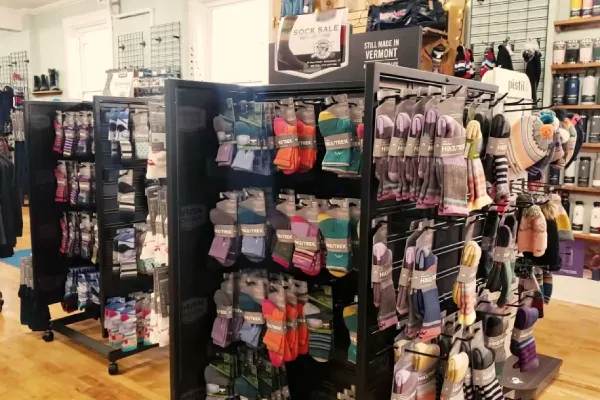
Not all skiers and snowboarders have the same requirements, nor do they need the same type of socks. If you’ve ever wondered what kind of socks to wear for snowboarding or skiing, the answer depends on your experience level, boot fit, and how long you’ll be out on the mountain. The best socks for skiing and snowboarding strike a balance between warmth, breathability, and performance tailored to your specific needs. Here’s a breakdown:
- Beginners and Rental Users: Durability and affordability are key. Many first-timers use rental boots, which may not fit perfectly, so medium-cushion socks that provide extra comfort and protection are ideal.
- Advanced Skiers and Snowboarders: Precision matters most. Ultralight or thin socks allow maximum sensitivity and control, which is why athletes and experienced riders prefer them.
- Ski Schools and Clubs: Beyond functionality, uniformity is important. Custom-branded socks with team colors or logos help foster identity and professionalism while maintaining the necessary warmth and comfort for long hours on the slopes.
- Retailers and Brands: Offering private-label or co-branded socks adds value and builds customer loyalty. Custom packaging and design allow businesses to differentiate themselves in a crowded market.
- Resorts and Travel Agencies: Branded ski socks can double as practical gear and promotional gifts. Resorts often use them for VIP guests, seasonal promotions, or group tours to enhance the guest experience and reinforce brand visibility.
Care and Maintenance
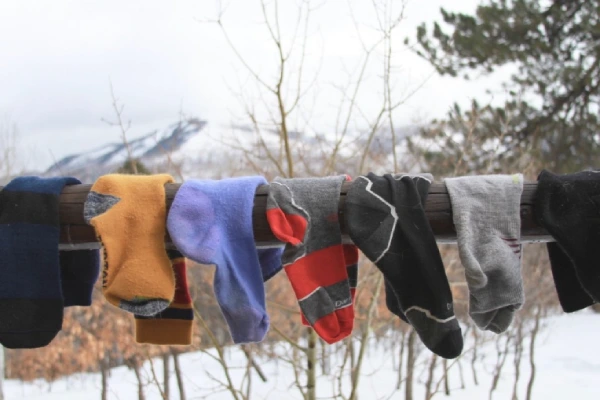
Proper care ensures that ski and snowboard socks—especially high-performance snowboarding socks and custom ski designs—stay comfortable, durable, and effective for many seasons. Whether you’re using merino wool, synthetics, or blended fibers, understanding what ski socks are made of helps you care for them properly and extend their life.
Wash Inside-Out in Cold or Warm Water
Turn your socks inside-out before washing to remove sweat and skin particles trapped in the fibers. Use cold or warm water with a mild detergent. Avoid bleach or fabric softeners, which can damage merino wool or reduce the moisture-wicking ability of synthetic fibers—essential for keeping your best socks for skiing and snowboarding fresh and functional.
Air Dry to Preserve Elasticity
High heat from dryers can shrink wool and weaken elastic fibers, shortening how long ski socks last. For maximum longevity, air-dry them flat or hang them in a well-ventilated area. If you must use a dryer, select the lowest heat setting to maintain shape and comfort.
Store Completely Dry
Always ensure your socks are fully dry before storing. Dampness can cause odors, fabric breakdown, or even attract moths if your socks contain wool. For long-term storage, consider adding cedar blocks or breathable bags to preserve freshness and fiber quality.
Rotate Pairs for Longevity
Using the same pair repeatedly accelerates wear and tear. Rotate between multiple pairs to give each set time to recover—especially for frequent skiers. Reinforced heels and toes are clear signs of high-performance ski socks built for durability and comfort across seasons.
FAQs
Can I wear regular cotton socks for skiing?
No, you would better not wear cotton socks for skiing or snowboarding. Cotton absorbs moisture and stays wet, which leads to cold, damp feet and blisters. Always wear technical ski socks made from merino wool or synthetic fibers that wick away sweat and keep your feet warm and dry.
Are ski socks really worth it?
Yes, ski socks are absolutely worth it. They provide warmth, moisture control, and cushioning that regular socks cannot. Good ski and snowboard socks also improve boot fit, prevent blisters, and help maintain proper circulation—key for staying comfortable on the slopes all day.
How many pairs of ski socks do I need for a trip?
You typically need two to three pairs of ski socks for a skiing or snowboarding trip. Rotating between pairs helps them dry fully, prevents odor buildup, and extends their lifespan—especially if you wear high-performance or compression ski socks.
Should I wear two pairs of socks when skiing?
No. Wearing two pairs of socks while skiing is a common mistake. Doubling up creates friction, restricts blood flow, and causes blisters. Instead, wear one good pair of thin or medium ski socks that fit snugly; this ensures better warmth, comfort, and boot control.
Are ski and snowboard socks the same?
Not exactly. Ski socks and snowboard socks differ slightly in design and padding. Snowboard socks often include more cushioning around the calf and heel, while ski socks prioritize a snug fit for better control. However, both use similar technical fabrics like merino wool or synthetics.
Conclusion
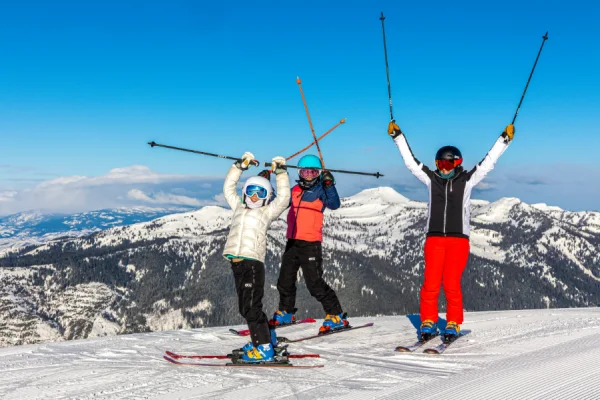
Ski and snowboard socks may seem like a small detail compared to boots or jackets, but they’re a key piece of gear that affects comfort, warmth, and performance. Choosing the right pair—made from technical materials with the right thickness and fit—makes the difference between ski and snowboard socks clear, and ensures every run feels better.
For individuals, investing in high-quality ski or snowboarding socks means skiing longer and staying warmer. For organizations, from ski schools to retailers, custom socks from Max Hosiery combine performance and branding—helping your team look and feel its best on the slopes.
